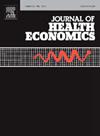预防性和治疗性医疗保健的非线性报销规则
IF 3.6
2区 经济学
Q1 ECONOMICS
引用次数: 0
摘要
本研究考察了二级预防和治疗护理的非线性报销规则。个人可能是健康的,也可能是生病的,疾病的严重程度决定了他们的离职类型。预防性护理是事先选择的,而治疗性护理是在了解健康状况后决定的。在健康状况可观察的理想情况下,最优保险提供与支出无关的一次性支付。然而,当严重程度是不可观察的(导致事后道德风险),这种方法是不兼容的激励。相反,最优保险设计的福利随着预防和治疗护理的增加而增加,因为更高的支出减少了信息租金并调整了激励措施。预防保健虽然是在疾病发生之前选择的,但由于两个因素,它会影响激励约束:(1)它对重病患者更有效;(2)他们的收入边际效用较低,这意味着预防性支出对他们的影响较小。这些影响形成了最优的补偿结构。此外,当个人误解预防保健的好处,主要结果保持不变,但一个额外的纠正(庇古)术语出现在报销公式调整这种误解。本文章由计算机程序翻译,如有差异,请以英文原文为准。
Nonlinear reimbursement rules for preventive and curative medical care
This study examines nonlinear reimbursement rules for secondary preventive and therapeutic care. Individuals may be healthy or ill, with illness severity determining their ex post type. Preventive care is chosen beforehand, while curative care is decided after health status is known.
In an ideal scenario where health status is observable, optimal insurance provides lump-sum payments unrelated to expenditures. However, when severity is unobservable (causing ex post moral hazard), this approach is not incentive-compatible. Instead, optimal insurance designs benefits that increase with both preventive and curative care, as higher expenditures reduce informational rents and align incentives.
Preventive care, though chosen before illness occurs, affects incentive constraints due to two factors: (1) it is more effective for severely ill individuals, and (2) they have lower marginal utility of income, meaning preventive expenditures impact them less. These effects shape the optimal reimbursement structure.
Additionally, when individuals misperceive preventive care benefits, the main results hold, but an extra corrective (Pigouvian) term appears in the reimbursement formula to adjust for this misperception.
求助全文
通过发布文献求助,成功后即可免费获取论文全文。
去求助
来源期刊

Journal of Health Economics
医学-卫生保健
CiteScore
6.10
自引率
2.90%
发文量
96
审稿时长
49 days
期刊介绍:
This journal seeks articles related to the economics of health and medical care. Its scope will include the following topics:
Production and supply of health services;
Demand and utilization of health services;
Financing of health services;
Determinants of health, including investments in health and risky health behaviors;
Economic consequences of ill-health;
Behavioral models of demanders, suppliers and other health care agencies;
Evaluation of policy interventions that yield economic insights;
Efficiency and distributional aspects of health policy;
and such other topics as the Editors may deem appropriate.
 求助内容:
求助内容: 应助结果提醒方式:
应助结果提醒方式:


